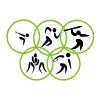Astylos of Croton
 From Wikipedia the free encyclopedia
From Wikipedia the free encyclopedia
Astylos of Croton or Astylus of Croton (Ἄστυλος/Ἀστύαλος ὁ Κροτωνιάτης) was an ancient athlete who competed in three successive Olympic Games. In 488 and 484 BC he won the stadion and diaulos; in 480 BC he won the stadion, diaulos, and hoplitodromos.[1] Astylos originally represented Croton, but later raced on behalf of Syracuse,[a] according to Pausanias to please Hiero, brother of the tyrant of Syracuse.[1] David Young suggests that Astylos' change of allegiance was solely economically motivated, arguing that Hiero "simply bought Astylos' services".[1]
After Astylos switched allegiance to Syracuse, the people of Croton took down a statue erected in his honour, and turned his house into a prison.[2] Astylos' victory is the last known victory by an athlete from Croton in any of the four major Greek athletic competitions.[3]
Nothing is known of Astylos' origin. H. W. Pleket claims that he was a nobleman, but there is no ancient evidence for this; David Young argues that it is unlikely that a nobleman would have chosen to represent Syracuse at the Olympics over his home city.[4] He commissioned Simonides for an epinicion and Pythagoras of Samos for a statue in Olympia.[5]
See also[edit]
Notes[edit]
References[edit]
- ^ a b c d Young, David C. (1984). The Olympic Myth of Greek Amateur Athletics. p. 141.
- ^ Antonaccio, Carl (2013). "Sport and Society in the Greek West". In Christesen; Kyle (eds.). A Companion to Sport and Spectacle in Greek and Roman Antiquity. p. 194.
- ^ Antonaccio, Carl (2013). "Sport and Society in the Greek West". In Christesen; Kyle (eds.). A Companion to Sport and Spectacle in Greek and Roman Antiquity. p. 195.
- ^ Young, David C. (2014). "Professionalism in Greek Athletics". In Scanlon, Thomas F. (ed.). Sport in the Greek and Roman Worlds. p. 88.
- ^ Young, David C. (1984). The Olympic Myth of Greek Amateur Athletics. p. 142.
